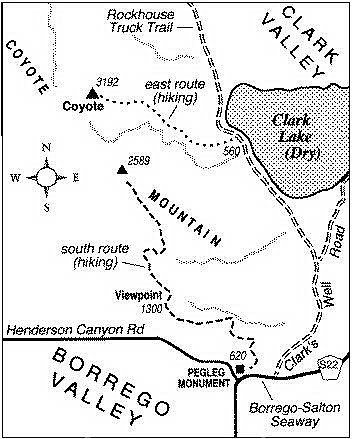 Facebook
Facebook
 X
X
 Instagram
Instagram
 TikTok
TikTok
 Youtube
Youtube
The desolate ridge of Coyote Mountain rises like the dark, furrowed flank of an elephant over the sand-drowned Borrego and Clark Valleys in the north part of Anza-Borrego Desert State Park. Scattered amid slabs of granitic and metamorphic rocks 100- to 300-million-years old, skeletal creosote-bush shrubs, soft, globular brittlebush plants, and various cacti well armored with spines cling with tough roots to tenuous pockets of granular soil. The attraction for hikers here is not so much what lies at their feet (though the springtime displays of brittlebush flowers can be eye-popping), but rather it's the pseudo-aerial views afforded in nearly every direction. The higher you go on the mountain, the broader and better the view.
Of the many possible routes to or toward Coyote Mountain's 3192-foot summit, I'll mention two. For either route, be sure to wear sturdy boots and take along plenty of water.
* South route, 11 miles round trip to summit. Park at the Pegleg Monument northeast of Borrego Springs, and head (on foot only) northward up the remains of a little-used and now-abandoned jeep road up the flank of the mountain. After about 2 miles, you reach a point on the steep southwest escarpment of Coyote Mountain that offers a fine view of Borrego Valley. Down below, a flat patchwork of tamarisk windbreaks, open fields, citrus orchards, palm nurseries, golf links, and scattered houses stretches several miles. Casual hikers will probably want to stop at this viewpoint and turn around. Strong and motivated hikers can continue another 2.5 miles up the more sketchy remnants of the same road and then hoof it cross-country over the remaining mile of ridge to the summit.
* East route, four miles round trip. This is the "elevator" route to the summit, with very little effort wasted on horizontal travel. Just east of Pegleg Monument, turn north of Clark's Well Road and drive 3.5 miles north, skirting the "shore" of Clark Dry Lake, to a clearing on the left, near the foot of Coyote Mountain. On foot, simply go straight up the steep slope to the west. This is basically a walk-up ascent, though quite steep. You'll need strong legs, a good wind, and a good sense of balance. Outcrops of solid, dark, desert-varnished rock provide good footing on the lower slopes. Higher up, a veneer of small stones underfoot makes climbing more difficult. While you are climbing, pause now and again to look behind you. Beyond the dry lake seemingly lying at your feet, the ravine-slashed Santa Rosa Mountains rise abruptly into the sky some 6000 feet. Contemplation of this scene is a stupefying exercise guaranteed to make you feel very small.


The desolate ridge of Coyote Mountain rises like the dark, furrowed flank of an elephant over the sand-drowned Borrego and Clark Valleys in the north part of Anza-Borrego Desert State Park. Scattered amid slabs of granitic and metamorphic rocks 100- to 300-million-years old, skeletal creosote-bush shrubs, soft, globular brittlebush plants, and various cacti well armored with spines cling with tough roots to tenuous pockets of granular soil. The attraction for hikers here is not so much what lies at their feet (though the springtime displays of brittlebush flowers can be eye-popping), but rather it's the pseudo-aerial views afforded in nearly every direction. The higher you go on the mountain, the broader and better the view.
Of the many possible routes to or toward Coyote Mountain's 3192-foot summit, I'll mention two. For either route, be sure to wear sturdy boots and take along plenty of water.
* South route, 11 miles round trip to summit. Park at the Pegleg Monument northeast of Borrego Springs, and head (on foot only) northward up the remains of a little-used and now-abandoned jeep road up the flank of the mountain. After about 2 miles, you reach a point on the steep southwest escarpment of Coyote Mountain that offers a fine view of Borrego Valley. Down below, a flat patchwork of tamarisk windbreaks, open fields, citrus orchards, palm nurseries, golf links, and scattered houses stretches several miles. Casual hikers will probably want to stop at this viewpoint and turn around. Strong and motivated hikers can continue another 2.5 miles up the more sketchy remnants of the same road and then hoof it cross-country over the remaining mile of ridge to the summit.
* East route, four miles round trip. This is the "elevator" route to the summit, with very little effort wasted on horizontal travel. Just east of Pegleg Monument, turn north of Clark's Well Road and drive 3.5 miles north, skirting the "shore" of Clark Dry Lake, to a clearing on the left, near the foot of Coyote Mountain. On foot, simply go straight up the steep slope to the west. This is basically a walk-up ascent, though quite steep. You'll need strong legs, a good wind, and a good sense of balance. Outcrops of solid, dark, desert-varnished rock provide good footing on the lower slopes. Higher up, a veneer of small stones underfoot makes climbing more difficult. While you are climbing, pause now and again to look behind you. Beyond the dry lake seemingly lying at your feet, the ravine-slashed Santa Rosa Mountains rise abruptly into the sky some 6000 feet. Contemplation of this scene is a stupefying exercise guaranteed to make you feel very small.
